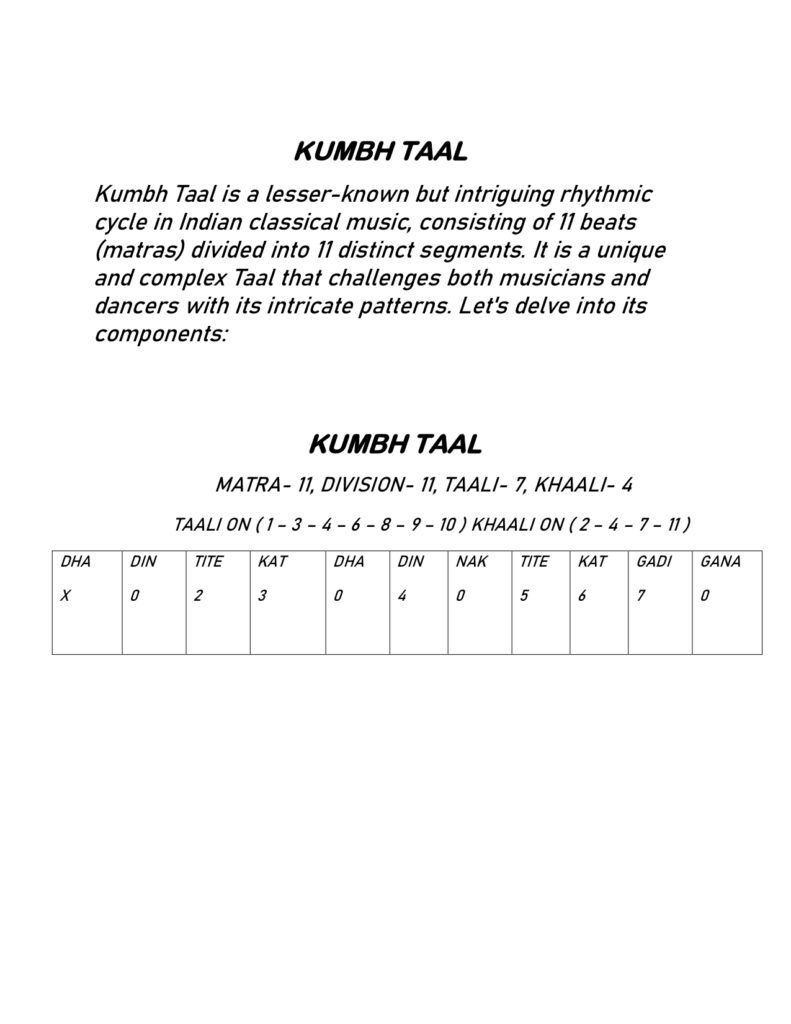Kumbh Taal Matra-11, Kumbh Taal is a lesser-known but intriguing rhythmic cycle in Indian classical music, consisting of 11 beats (matras) divided into 11 distinct segments. It is a unique and complex Taal that challenges both musicians and dancers with its intricate patterns. Let’s delve into its components:
Introducing the-

https://www.youtube.com/@BhagawanSingh
https://www.facebook.com/sbsinghtablaguru
Kumbh Taal is a lesser-known but intriguing rhythmic cycle in Indian classical music, consisting of 11 beats (matras) divided into 11 distinct segments. It is a unique and complex Taal that challenges both musicians and dancers with its intricate patterns. Let’s delve into its components:
Structure of Kumbh Taal
- Matras (Beats): 11
- Vibhags (Divisions): 11 (each with one beat)
- Taali (Claps): Occurs on beats 1, 3, 4, 6, 8, 9, and 10
- Khaali (Wave, i.e., No Clap): Happens on beats 2, 5, 7, and 11
Historical Context
Kumbh Taal, like many Taals in Indian classical music, has roots that are not precisely documented but are part of a long tradition of sophisticated rhythmic structures used in Indian music. It is less commonly used compared to more prominent Taals like Teentaal or Ektaal, which consist of simpler and more conventional beat cycles. The complexity of Kumbh Taal makes it fascinating for experimentation in both classical performances and fusion music styles.
Taal and Indian Classical Music
In Indian classical music, the concept of Taal is crucial as it serves as the rhythmic foundation. Different Taals are chosen based on the mood, complexity, and style of the composition. Kumbh Taal, with its distinct beat pattern, offers a unique platform for musicians to explore creative expressions and intricate compositions.
Popular Songs and Performances Utilizing Kumbh Taal
Due to its complexity, Kumbh Taal is not very common in mainstream Bollywood or classical music recordings easily accessible to the public. However, it might be employed in classical performances, tabla solos, and fusion projects that explore unconventional rhythms. Musicians interested in complex rhythmic expressions might use Kumbh Taal in contemporary compositions or experimental works, though specific popular tracks could be hard to identify as they are often part of live and exploratory classical performances rather than mainstream music.
Conclusion
Kumbh Taal serves as a fascinating example of the rich tapestry of rhythmic frameworks in Indian music, offering a specialized platform for showcasing a musician’s technical skill and innovation. Whether in the setting of a classical concert or a modern fusion experiment, Kumbh Taal’s unique structure can present both a challenge and an exciting opportunity for rhythmic exploration.

